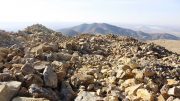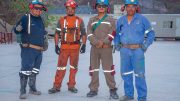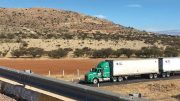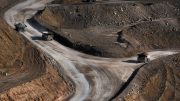Throughout his career, and as a founder of Castle Gold, Darren Koningen brought two profitable heap-leach gold mines into production on time and under budget: El Sastre in Guatemala and El Castillo in Mexico.
Today, the metallurgical engineer heads Minera Alamos (TSXV: MAI), a Mexico-focused junior that is advancing the La Fortuna project in Sinaloa. La Fortuna was one of several assets in Mexico — including the El Castillo mine — that Koningen had worked on at Castle Gold, before Argonaut Gold (TSX: AR) snapped up the company for $130 million in 2009.
Last year Koningen and his team at Minera Alamos bought La Fortuna from Argonaut for $2 million in cash and a 2.5% royalty capped at $4.5 million.
“We had been looking for years to try to get La Fortuna back,” Koningen says in an interview. “The timing was good for us — we were coming out of the end of 2015, when the markets were pretty awful.”
La Fortuna is situated in Durango in the prolific Sierra Madre Occidental Range. It can be accessed by a 100 km road from Culiacan, the capital of Sinaloa.
The main zone of the deposit — which is located within a limited, 300-metre strike length that was drilled in the mid-1990s — has a measured and indicated resource of 4.8 million tonnes grading 1.99 grams gold per tonne. The main zone is open to depth and along strike.

Minera Alamos president and CEO Darren Koningen (left) and vice-president Miguel Cardona in the field in Mexico. Credit: Minera Alamos.
Previous drilling at the La Fortuna main zone in the mid-1990s occurred on only one of at least four known gold mineralization systems, Koningen says, and while there are remnants of historic mining across the project area, no modern drilling or systematic exploration has ever been completed elsewhere on the property.
After securing the project last year, Minera Alamos has added to the company’s footprint in the area, acquiring more land south of the main resource and bringing the project’s total land package to 62 square kilometres.
It has also brought in Osisko Gold Royalties (TSX: OR) as a strategic partner.
In May, Osisko bought just over 22 million shares at 15¢ for a 19.9% stake in the company.
Osisko has the right to participate in future equity financings up to its pro rata ownership, pre-financing, and can nominate up to two members to the board.
Osisko also has the option to buy up to a 4% net smelter return royalty on La Fortuna for $9 million in cash upon a construction decision, and will have the right to participate in half of any buybacks of existing royalties.
Koningen says the partnership will help Minera Alamos fast track La Fortuna toward production and expand its presence in Mexico organically, and through more acquisitions.
In a May 30 press release announcing the agreement, Sean Roosen, Osisko’s chairman and CEO, said he looked forward to working with Koningen and his team to “advance La Fortuna, as well as other opportunities in Mexico and elsewhere in Central and South America, as they become available.
“The La Fortuna main zone is a great starter project, with lots of exploration potential. But Osisko did not get involved just for helping us with La Fortuna,” Koningen says. “They have bigger intentions and lots of capital to deploy, so it’s the start of a working relationship, as we do more transactions in Latin America.”
For now, however, the company is Mexico-focused and Koningen hopes to complete a preliminary economic assessment, secure surface rights and submit permit applications before the end of September. If all goes according to plan, management expects to complete a detailed construction plan in the fourth quarter, and receive permits and make a construction decision in the first quarter of 2018.
In August, the company hired Robelsis Altamirano to manage advanced exploration aimed at expanding the resource base at La Fortuna. Altamirano worked previously with the company’s Mexican technical team and was exploration manager for Argonaut Gold’s south extension of the El Castillo mine. He was also involved in the discovery and delineation of Torex Gold Resources’ (TSX: TXG) Media Luna gold project in Mexico’s Guerrero gold belt, when he was part of the Teck-Cominco group in Mexico.
“He helped us at Castle Gold when we were developing the El Castillo project,” Koningen says. “He’s a seasoned, capable exploration manager. He’s good in the camp, he’s good with structural geology and has a track record of putting together big gold resources, so he’s a perfect fit … he’ll be stationed at the La Fortuna mine site, and he’s been going through all the old historic data and trying to pull structures together, and get a better understanding of the whole system.
“We’ve been talking about three or four systems here, and we need someone to put them together and do the geophysical work,” Koningen adds. “He put together Media Luna and expanded known systems there, and that’s what we’re doing here.”
Koningen says that over the last few months the company has learned more about mineralizing events in the La Fortuna area.
Target areas for resource expansion include surface mineralization north of the main zone and 400 to 500 metres south along strike. These areas were targeted by previous owners for a second-phase drill program in the late 1990s, but was cancelled due to the depressed gold price at the time.
Another prospective area occurs at the northern end of the land package dubbed PN. PN presents the potential for a large, bulk-tonnage gold-silver system contained within a shear zone at the intersection of two major fault systems. The system can be followed at surface for 1.5 km and has numerous old mine workings. Sampling has returned gold grades ranging from 1 gram gold per tonne to 10 grams gold per tonne, and between 50 grams silver per tonne and 400 grams silver per tonne.
In the Ramada zone, between the Fortuna main and PN zones on a parallel fault structure, mineralization has been traced at surface for 600 metres and has grades of up to 40 grams gold per tonne from sampling at surface and inside historic mine workings.
In the recently acquired Cerro Pelon zone, south of the major east–west fault system that passes through the project area, it appears erosion has exposed deeper porphyritic rocks. Minera Alamos says the Cerro Pelon area, 4 to 5 km southwest of the main zone, also has historic workings, and was delineated by the Mexican Geological Service to contain a 3 to 5 km area of anomalous and disseminated gold showings.
Minera Alamos is reviewing historic data and drill information, as well as surface mapping and drill targeting to evaluate extensions north and south of the previously drilled resource in the main zone. The company intends to finish a geophysical survey over the entire area, map the PN zone to find drill targets, and map the porphyritic gold anomaly that SGM found in the project’s southern boundaries.
The exploration work, including a 3,000-metre drill program, will be funded with some of the $5.4 million the company raised in a June private placement.
While Minera Alamos looks for assets in the Caribbean, the northern part of South America, Chile and Peru, Koningen says the company’s focus remains on Mexico.
“We think there are still good opportunities,” he says. “Our strengths are operationally putting things into production. We’re pretty creative and capable of getting things up and running, so we have that expertise.”
In addition to La Fortuna, Minera Alamos owns the Los Verdes copper-moly project, 200 km southeast of Hermosillo in Sonora state. But this project is on the back burner for now.
“Copper prices seem to have stabilized so we’ve had some interest again, but we haven’t made a decision on what to do,” he says. “We’ve started having conversations with the possibility of joint-venturing, spinning out into a copper group with other assets or potentially leaving it in the stable and developing it later.”
As for the risks of operating in Mexico, Koningen says it boils down to being in the right area.
“You have to be selective in Mexico,” he says. “The company has always been Mexican-driven. At Castle Gold, there were very few people from Canada. All of the primary management team was Mexico-based, and we operate in that manner. We are careful where we go. There are parts of the country where we are not comfortable with, but there are large sections of the country where we’re more than comfortable working in, and have been working in for more than a decade.”






Be the first to comment on "Minera Alamos reels in Osisko Gold Royalties"